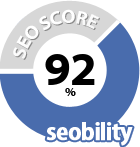Search engine optimisation (SEO) is a decisive factor for the visibility of websites on the Internet. SEO means designing your website and its content in such a way that search engines can easily recognise and index it. Optimising your website can make your content easier to find for your target group and drive more qualified traffic to your site.
In this article, I explain in 7 steps how you can create your content in a search engine optimised way.
1. formulate the key points of your company presentation
Firstly, the Key points of your company presentation be clear. You will need it as a basis for the next steps. If you are still in the discovery or reformulation phase, read the article "Checklist - How do you present your company on your website?", which can help you with this.
Checklist - How do you present your company on your website?
2. keyword research
Before you start writing content, you should carry out thorough keyword research. Tools such as Google Keyword Planner or Seobility can help with this. Choose keywords that are relevant to your topic and have a high search volume. Make sure to include both main and secondary keywords (long-tail keywords) in your content.
The simplest version of Seobility is a free tool for website analysis and search engine optimisation:
Seobility Keyword Research Tool
3. creation of content
When creating content, focus on creating high-quality, informative and unique articles. Your content must focus on the needs and questions of your target audience and naturally incorporate your chosen keywords. Also take the opportunity to set internal and external links to improve the user experience and support search engine optimisation.
4. use of SEO plugins
There are a number of SEO plugins for WordPress, such as SEOPress or Rank Math, which help you to optimise your content for search engines. These plugins allow you to add meta titles and meta descriptions, customise your URL structure, create XML sitemaps and perform many other SEO tasks.
5. optimisation of images
Images can make your website more appealing, but they can also help your SEO. Make sure your images are optimised by using the modern .webp image format and compressing them, adding alternative text and attribution and embedding them correctly.
Click here for instructions on image optimisation for your website
6. optimisation of the page speed
The loading speed of a website is an important ranking factor for search engines. Tools such as Google PageSpeed Insights can help you to check the speed of your website and make improvements.
A good WordPress host with fast servers and server caching provides the technical basis for short loading times. It is just as important to use a leanly programmed and fast theme. Plugins such as Autoptimise can also help to speed up your website.
7. mobile optimisation
Google and other search engines favour mobile-friendly websites. Therefore, make sure that your WordPress website is fully responsive and works well on all major screen sizes.
Summary:
Search engine optimised creation of website content
Key points of the company presentation
Formulate the key points of your company presentation for your web presence.
Keyword research
Find relevant and high-volume keywords for your content.
Content creation
Create high-quality and unique content that naturally incorporates your keywords.
Use of SEO plugins
Use plugins such as SEOPress / Rank Math / Yoast SEO to optimise your content on-page.
Image optimisation
Compress images before uploading them to your WordPress media centre! Use the .webp format. Add alt texts and copyright information and integrate them into your website.
Optimisation of the page speed
Use a server cache or plugins to improve the loading speed of your website.
Mobile optimisation
Make sure that your website works well on all screen sizes.
By following these simple steps, you can create search engine optimised content and improve your visibility in search engines. It takes patience and constant work, but the results can be significant.
Service for your website

